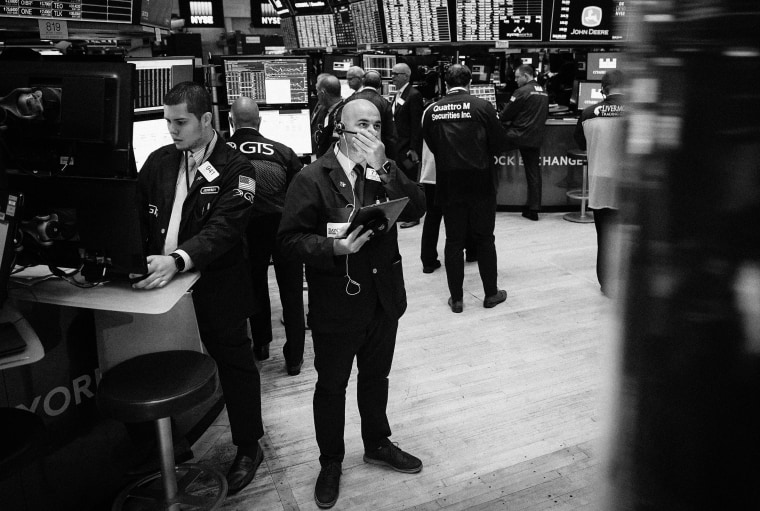Since his first day in office, President Donald Trump has been the copywriter-in-chief behind a nearly three-year marketing campaign for the so-called best economy ever, incessantly tweeting about a soaring stock market and record-low unemployment rates.
But the stock market chaos we’ve witnessed in recent weeks exposes the lie at the heart of this public relations campaign. And while market volatility can sometimes mean a bounce upward as well, the more significant economic indicators are even more revealing of the poor state of the economy once Trump’s hype has been dispelled.
The stock market chaos we’ve witnessed in recent weeks exposes the lie at the heart of this public relations campaign.
The truth is that the numbers that Trump holds up as proof of a thriving economy are masking an economy that, according to the two most credible early indicators, is actually on the precipice of a recession. One indicator is how Treasury bonds are doing, and Wednesday things went badly. The yield on 10-year bonds fell below the rate on the 2-year Treasury bond — this phenomenon, known as an inverted yield curve, has always been a reliable early indicator of a recession because it best reflects bondholders’ short-term expectations for the economy.
The other indicator is unemployment. Despite an official Bureau of Labor Statistics unemployment count of 6.1 million unemployed workers, the real unemployed worker figure is more like 11.5 million. By not counting the 1.5 million “marginally attached” and “discouraged” workers, and especially by not counting the 4 million workers who are “part-time-of-necessity,” Trump’s official figure fails to capture the severe economic pain still being felt by far too many workers.
Of course, this undercounting of the real number of unemployed is just one piece of the larger picture, as there are tens of millions of counted workers who try to survive every day on low or minimum wages with marginal or no health insurance, sick leave, retirement security or parental leave. And then there are the millions of part-time workers who have no benefits at all.
Meanwhile, the rich keep getting richer. In fact, the richest 1 percent have today a combined income that is 188 times greater than the bottom 90 percent of earners. Moreover, those fortunate few at the top account for 40 percent of the country’s net assets. Consider this: Forty percent of American families struggle each day just to pay their bills. One is hard-pressed to imagine these families thinking that we’re living in the “best economy we’ve ever had.”
To be fair, Trump is not to blame for all of the economic pain currently being felt around the country. But he is to blame for whitewashing it away in an effort to score political points — and not taking responsibility when things go wrong.
As is typical, Trump quickly scapegoated the Federal Reserve for Wednesday’s massive losses in the stock markets. In one tweet, he called the body’s chairman, Jay Powell, “clueless” before declaring: “We should easily be reaping big Rewards & Gains, but the Fed is holding us back. We will Win!”
But Wednesday’s losses were deep and across the board, meaning they are structural, they’re for real, and they’re foreboding. They cannot be pinned on how the Fed set interest rates. Instead, they are clear evidence of how Trump’s notion of a soaring economy is an alternate reality.
Our nation has faced deep structural economic problems before, and unlike Trump, our leaders of the past would rise to their challenges by being forthcoming about the problems in front of them — and about the bold solutions needed.
Faced with the despair and impoverishment of the Great Depression, Franklin Delano Roosevelt seized the reins of the Democratic Party and gained the trust of the country by honestly addressing the economic challenge before it. FDR brought a focused vision and a comprehensive agenda to fix the problems.
Notably, he appointed Marriner Eccles, a banker from Utah and an early mentor of mine, as Fed Chairman from 1934 until 1948. This appointment was made because of FDR’s embrace of Eccles’ 1933 Senate testimony in which he laid out, as no one had before, the need to overhaul the prevailing model of capitalism and rein in the outsize influence of Wall Street on everyday Americans.
Eccles’ solution? He proposed higher and more progressive income and inheritance taxes as being essential to promoting economic growth, curbing inequality and forestalling political instability.
It’s illuminating that Eccles, who helped draft the Banking Act of 1933 (known as Glass-Steagall) and the Banking Act of 1935 that together would provide more oversight of and reduce the power of the banks, would, like FDR, find his motivation in a career-long battle against pervasive income inequality.
Our leaders of the past would rise to their challenges by being forthcoming about the problems in front of them – and about the bold solutions needed.
Today, we desperately need a new Roosevelt, and thereafter a new Eccles. We need leaders who are willing to level with the American people about the real challenges confronting workers and their families.
The first step is pointing out the obvious: This is simply not at all the “best economy we’ve ever had.”
Economic issues consistently rank as a top concern for both Democrats — of which I’m one — and independents. Democratic 2020 candidates must start doing a better job of both exposing the dirty truths behind Trump’s overblown tweets, and reminding the electorate that it’s the Democratic Party that knows who’s really unemployed and chronically underemployed.
And it’s only the Democratic Party that has the solutions to the pernicious income and wage inequalities that plague our society and our economy.


